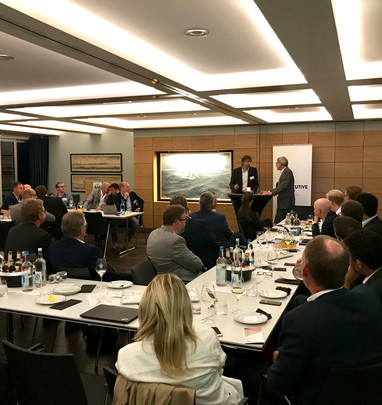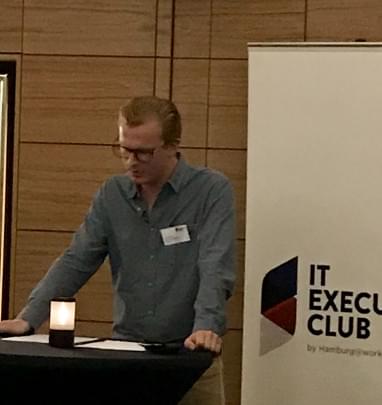20 October 2018
IT Executive Club | Report from Club Evening on 16 October 2018
Club evening with Alexander Graubner-Müller:
""Looking back after 6 years: Lessons learned in the scaling of platform and organization"
The technical platform for a digital financial business model - new, but actually no longer a start-up - was the focus of the ITEC club evening, which was again extremely well attended. However, the agenda traditionally began with two club members revealing in an interview what their professional and personal lives were about.
Interview with Dr. Horst Karaschewski:
Dr. Dr. Horst Karaschewski has been head of IT application development at Hanse Merkur Insurance Group since 2006. With the introduction of a service-oriented architecture (SOA) and agile working methods in 2008, a wave of innovation began in the IT of the insurance company, which in 2014 lead to the replacement of mainframe technology and to future the orientation towards cloud computing. In the same year, the – like all agile topics – organizationally challenging subject of "Continuous Integration/Continuous Delivery" (CI/CDE) was put on the agenda. His courageous conclusion after ten years of agility: IT employees are more likely to be able to do this because of their way of thinking than their colleagues from the specialist departments. Also remarkable: In order to be able to exploit the potential of agile work without overtaxing the forces that are used to traditional, hierarchical work, the spin-off Red6 Enterprise Software GmbH was founded in 2013, which develops innovative insurance solutions as an agile enclave within the group.
Interview with Tim Angerer:
Tim Angerer has been head of the Media Office of the Hanseatic City of Hamburg since the beginning of 2017. When asked what relevance this would have for IT, he first pointed out that the Office was responsible not only for the media industry but also for the IT industry and that it generally steers digital innovation. He made the following calculation: The number of jobs lost in the publishing industry as a result of the advertising crisis and digitalization - between 2009 and today the number of employees in the Hamburg-based media companies fell from just under 12,000 to 8,000 - is being compensated several times in the digital economy: In the IT and telecommunications positions of all sectors in Hamburg, 13,000 more people are now employed in jobs subject to social insurance contributions than in 2009; the bottom line is an increase of 9,000 jobs.
Angerer sees Hamburg on the right track: "The bottom line is that the city is growing in digital and media terms." He mentioned the Hamburg-based companies Xing, Mytaxi, Facebook, Google, Snap and Twitter as examples of success. And with the Brexit, companies from the UK could be added who would like to settle in an environment that traditionally fits in well with the British style (with English-speaking schools, good flight connections to London and even golf and polo courts). The target set by the new First Mayor, Peter Tschentscher, to provide Hamburg with fibre-optic house connections by 2025, was a further competitive advantage for Angerer.
Presentation by Alexander Graubner-Müller, Kreditech
was CTO and then CEO of the Hamburg-based Fintech company Kreditech, which he founded in 2012; in May 2018 he retired from day-to-day business and is now active as an investor and business angel. In his presentation, he looked back on the history of Kreditech and presented "Lessons learned in the scaling of platform and organization"
Kreditech has developed a procedure to use up to 20,000 individual points from various data sources to replace conventional credit agencies when assessing the solvency of borrowers. Initially it had been planned to offer this service to other financial institutions via software-as-a-service channels in the cloud. However, this B2B business model would very soon be converted into a B2C model with its own customers and loan granting. However, Kreditech does not have a banking license, so no business is transacted in Germany. Today, the company offers its services in Poland, Spain, Russia, India and Mexico; it employs 400 people, 200 of them in Hamburg, the others at development locations in Warsaw and Kharkiv/Ukraine.
According to Graubner-Müller, architecture, business and organization developed into a status that is difficult to manage in the first few years of business: The business was organized by country, but the product teams were organized by products developed for several countries. And the architecture was characterized by business logics distributed across all components. This led to a very high need for coordination between product managers, technical leads and business managers – with a corresponding slowdown in processes. This was the solution that was avoided because of the expected effort, but was then tackled: From 2017, the technological platform was newly developed in a micro services architecture, as was the entire organizational model. Non-value-creating components of the software were no longer developed in-house, but purchased on the market if there were suitable solutions. However, core functions such as the risk model on which the credit assessment is based were not given out of hand; this is now based on an easily scalable container solution.
Graubner-Müller's conclusion: "Software in production environments should be completely renewed every five years." In order to achieve this, however, it makes sense to split the software team into a part dedicated to the ongoing operation of the still active solution and a part dedicated solely to new development.



